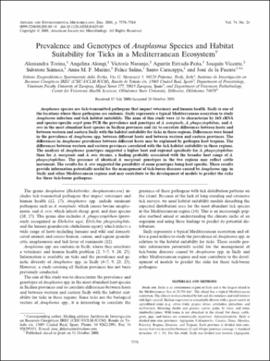| dc.contributor.author | Torina, Alessandra | |
| dc.contributor.author | Alongi, Angelina | |
| dc.contributor.author | Naranjo, Victoria | |
| dc.contributor.author | Estrada-Pena, Agustin | |
| dc.contributor.author | Vicente, Joaquin | |
| dc.contributor.author | Scimeca, Salvatore | |
| dc.contributor.author | Marino, Anna M. F. | |
| dc.contributor.author | Salina, Felice | |
| dc.contributor.author | Caracappa, Santo | |
| dc.contributor.author | de la Fuente, Jose | |
| dc.date.accessioned | 2018-08-29T14:24:28Z | |
| dc.date.available | 2018-08-29T14:24:28Z | |
| dc.date.issued | 2008-12 | |
| dc.identifier | oksd_torina_prevalenceandge_2008 | |
| dc.identifier.citation | Torina, A., Alongi, A., Naranjo, V., Estrada-Pena, A., Vicente, J., Scimeca, S., ... de la Fuente, J. (2008). Prevalence and genotypes of Anaplasma species and habitat suitability for ticks in a Mediterranean ecosystem. Applied and Environmental Microbiology, 74(24), 7578-7584. https://doi.org/10.1128/AEM.01625-08 | |
| dc.identifier.uri | https://hdl.handle.net/11244/301600 | |
| dc.description.abstract | Anaplasma species are tick-transmitted pathogens that impact veterinary and human health. Sicily is one of the locations where these pathogens are endemic. Sicily represents a typical Mediterranean ecosystem to study Anaplasma infection and tick habitat suitability. The aims of this study were (i) to characterize by 16S rRNA and species-specific msp4 gene PCR the prevalence and genotypes of A. marginale, A. phagocytophilum, and A. ovis in the most abundant host species in Sicilian provinces and (ii) to correlate differences between hosts and between western and eastern Sicily with the habitat suitability for ticks in these regions. Differences were found in the prevalence of Anaplasma spp. between different hosts and between western and eastern provinces. The differences in Anaplasma prevalence between different hosts may be explained by pathogen host tropism. The differences between western and eastern provinces correlated with the tick habitat suitability in these regions. The analysis of Anaplasma genotypes suggested a higher host and regional specificity for A. phagocytophilum than for A. marginale and A. ovis strains, a finding probably associated with the broader host range of A. phagocytophilum. The presence of identical A. marginale genotypes in the two regions may reflect cattle movement. The results for A. ovis suggested the possibility of some genotypes being host specific. These results provide information potentially useful for the management of tick-borne diseases caused by Anaplasma spp. in Sicily and other Mediterranean regions and may contribute to the development of models to predict the risks for these tick-borne pathogens. | |
| dc.format | application/pdf | |
| dc.language | en_US | |
| dc.publisher | American Society for Microbiology | |
| dc.rights | This material has been previously published. In the Oklahoma State University Library's institutional repository this version is made available through the open access principles and the terms of agreement/consent between the author(s) and the publisher. The permission policy on the use, reproduction or distribution of the material falls under fair use for educational, scholarship, and research purposes. Contact Digital Resources and Discovery Services at lib-dls@okstate.edu or 405-744-9161 for further information. | |
| dc.title | Prevalence and genotypes of Anaplasma species and habitat suitability for ticks in a Mediterranean ecosystem | |
| osu.filename | oksd_torina_prevalenceandge_2008.pdf | |
| dc.description.peerreview | Peer reviewed | |
| dc.identifier.doi | 10.1128/AEM.01625-08 | |
| dc.description.department | Veterinary Pathobiology | |
| dc.type.genre | Article | |
| dc.type.material | Text | |
| dc.subject.keywords | anaplasma marginale | |
| dc.subject.keywords | anaplasma ovis | |
| dc.subject.keywords | anaplasma phagocytophilum | |
| dc.subject.keywords | bacterial proteins | |
| dc.subject.keywords | membrane proteins | |
| dc.subject.keywords | phylogeny | |
| dc.subject.keywords | sicily | |
| dc.subject.keywords | ticks | |
